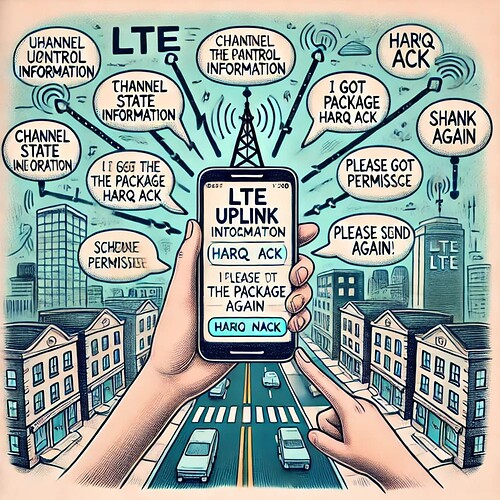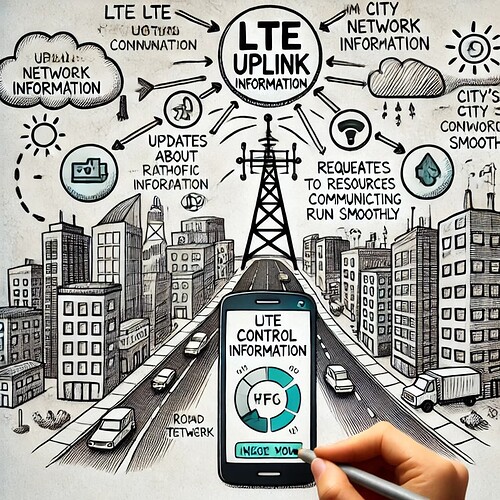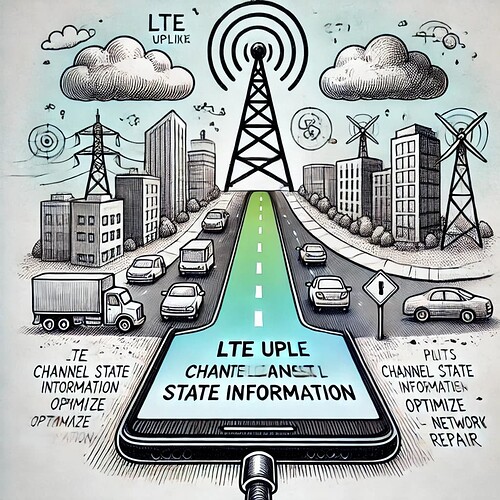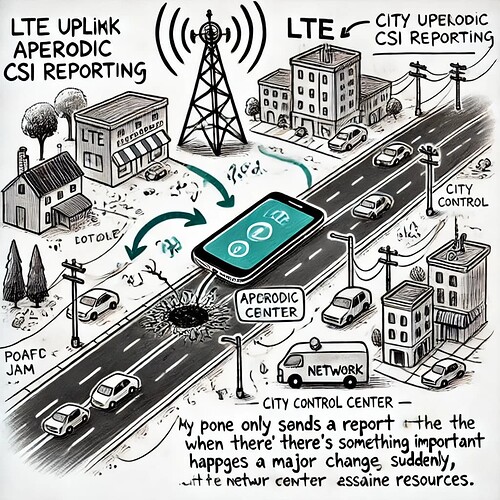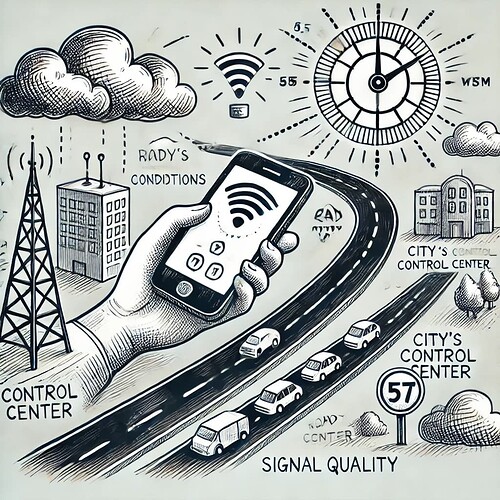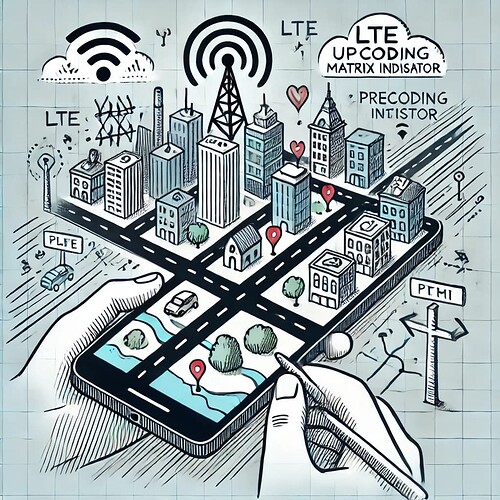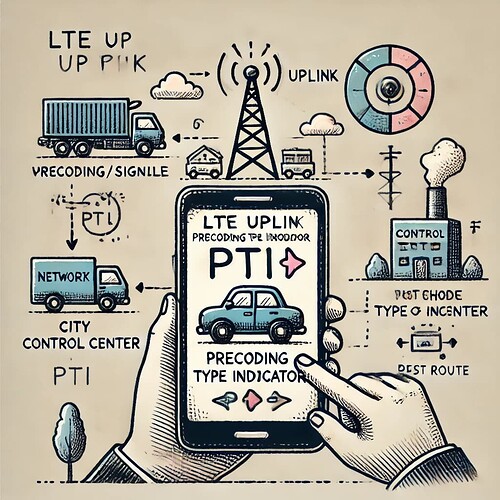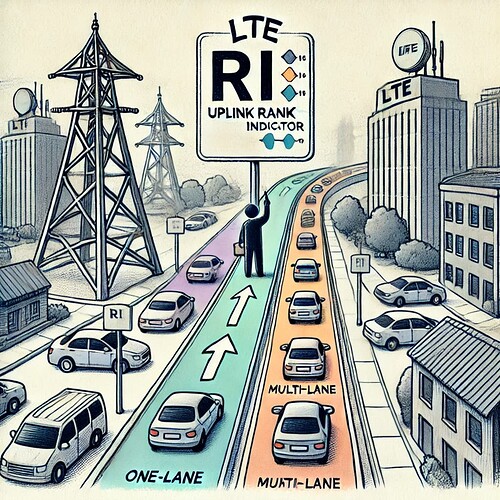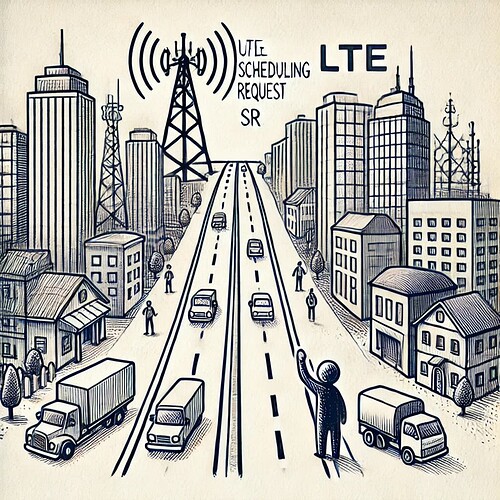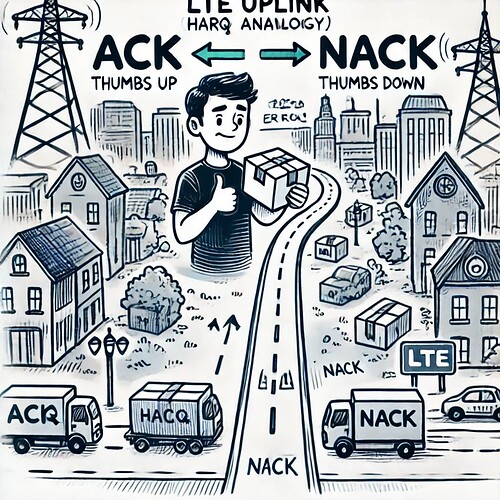This topic presents in a very simplified way all the main concepts that should be understood by those who know LTE.
LTE Uplink Control Information
LTE Uplink Control Information (UCI) refers to the signals sent from your device back to the network to help manage communication. UCI includes important feedback like Channel State Information (CSI), which reports the quality of the connection, and HARQ ACK/NACK, which confirms whether data was received correctly or needs to be resent. It also covers scheduling requests when the device needs to send data and other reports, such as the Rank Indicator (RI) and Precoding Matrix Indicator (PMI), which help optimize how the network sends data back to the device. UCI is essential for ensuring that data flows efficiently, that the connection is strong, and that errors are minimized, enabling smooth communication between the device and the network.
![]() Imagine LTE Uplink Control Information (UCI) as a conversation between your phone and the city’s control center (the network). Your phone sends updates like, “The roads are clear!” (Channel State Information), or “I got the package!” (HARQ ACK), or “Please send it again” (HARQ NACK). Sometimes, your phone raises its hand to ask for permission to send data (Scheduling Request), or tells the city how many lanes are open for data traffic (Rank Indicator). It’s like your phone is constantly sending little notes to help the city manage traffic and make sure deliveries are smooth, fast, and without mistakes.
Imagine LTE Uplink Control Information (UCI) as a conversation between your phone and the city’s control center (the network). Your phone sends updates like, “The roads are clear!” (Channel State Information), or “I got the package!” (HARQ ACK), or “Please send it again” (HARQ NACK). Sometimes, your phone raises its hand to ask for permission to send data (Scheduling Request), or tells the city how many lanes are open for data traffic (Rank Indicator). It’s like your phone is constantly sending little notes to help the city manage traffic and make sure deliveries are smooth, fast, and without mistakes.
Skip to: Roadmap to LTE
- UCI Introduction
- Channel State Information (CSI)
- Aperiodic CSI Reporting
- Periodic CSI Reporting
- Precoding Matrix Indicator
- Precoding Type Indicator
- Rank Indicator
- Scheduling Request
- HARQ ACK/NACK
UCI Introduction
Uplink Control Information (UCI) refers to the control signals that a device sends back to the network. These signals contain essential data about the quality of the connection, feedback on received data, and requests for resources. UCI helps the network make real-time decisions to optimize communication between the device and the network, ensuring the network understands the device’s status and needs. It is essential in LTE uplink, acting as the feedback system between your device and the network.
![]() Uplink Control Information (UCI) is like the important notes, essential updates your phone sends back to the city’s control center (the network) to keep it updated and to help everything run smoothly. These notes include things like how the roads (the network) are doing and whether your phone needs anything to keep communicating properly (important details that help the network understand what’s going on with your phone).
Uplink Control Information (UCI) is like the important notes, essential updates your phone sends back to the city’s control center (the network) to keep it updated and to help everything run smoothly. These notes include things like how the roads (the network) are doing and whether your phone needs anything to keep communicating properly (important details that help the network understand what’s going on with your phone).
- Search Forum
 LTE Uplink Control Information (UCI)
LTE Uplink Control Information (UCI) 
Channel State Information (CSI)
Channel State Information (CSI) is the feedback that the device provides to the network about the quality of the wireless channel (current state of the communication channel). It includes details about signal strength, interference, and other factors that affect communication quality. CSI helps the network adjust its transmission techniques to improve efficiency and data throughput (It helps the network understand how well it can send and receive data, adjusting parameters to optimize performance and maintain a strong connection).
![]() Channel State Information (CSI) is like your phone giving the city a report on how smooth or rough the roads are. It helps the city know whether the roads are clear, bumpy, or need fixing, so your phone can send data smoothly. It’s like your phone sending a road condition update to the network, letting it know how good or bad the connection is, so the network can adjust and keep the signal strong and stable.
Channel State Information (CSI) is like your phone giving the city a report on how smooth or rough the roads are. It helps the city know whether the roads are clear, bumpy, or need fixing, so your phone can send data smoothly. It’s like your phone sending a road condition update to the network, letting it know how good or bad the connection is, so the network can adjust and keep the signal strong and stable.
- Search Forum
 LTE Channel State Information (CSI)
LTE Channel State Information (CSI) 
Aperiodic CSI Reporting
Aperiodic CSI Reporting occurs when the device sends channel information to the network only when requested or when there is a significant change in the channel conditions. This reduces unnecessary updates and conserves resources, as the device only reports the channel state when needed. Sending CSI only when requested by the network conserves resources by providing updates on channel conditions only when needed, rather than at regular intervals.
![]() Aperiodic CSI Reporting is like sending a message the city only when there’s a change on the roads, like a big pothole or a traffic jam. Your phone sends this report only when something important happens, saving time and effort. It’s like sending a road condition update only when the network asks for it. This helps conserve resources by updating the network only when needed, instead of doing it all the time.
Aperiodic CSI Reporting is like sending a message the city only when there’s a change on the roads, like a big pothole or a traffic jam. Your phone sends this report only when something important happens, saving time and effort. It’s like sending a road condition update only when the network asks for it. This helps conserve resources by updating the network only when needed, instead of doing it all the time.
- Search Forum
 LTE Aperiodic CSI Reporting
LTE Aperiodic CSI Reporting 
Periodic CSI Reporting
Periodic CSI Reporting is when the device regularly sends CSI updates to the network at predefined fixed intervals. This consistent feedback allows the network to continuously monitor the channel quality and make adjustments, even if no significant changes occur. This constant feedback helps the network monitor channel conditions continuously and make timely adjustments to maintain optimal performance.
![]() Periodic CSI Reporting is like your phone regularly checking in with the city about the road conditions, even if everything is fine. It’s like sending a regular traffic report, ensuring the city knows everything is running smoothly. By providing updates at fixed intervals, the network constantly receives information about the connection quality, allowing it to make timely adjustments and keep everything flowing efficiently.
Periodic CSI Reporting is like your phone regularly checking in with the city about the road conditions, even if everything is fine. It’s like sending a regular traffic report, ensuring the city knows everything is running smoothly. By providing updates at fixed intervals, the network constantly receives information about the connection quality, allowing it to make timely adjustments and keep everything flowing efficiently.
- Search Forum
 LTE Periodic CSI Reporting
LTE Periodic CSI Reporting 
Precoding Matrix Indicator
The Precoding Matrix Indicator (PMI) is a signal sent from the device to the network that provides feedback on the best way to transmit data. It suggests which precoding matrix (method of transmitting multiple data streams) should be used, ensuring the most efficient use of the wireless channel. It informs the network about the preferred precoding matrix, which is used to shape the signals before transmission. This helps in improving the signal quality and overall data transmission efficiency.
![]() The Precoding Matrix Indicator (PMI) is like your device giving the city a map that shows the best route for delivering messages. It helps the network choose the most efficient path to send information to your phone without hitting any traffic. It’s like your phone guiding the network on the best way to send signals, ensuring they arrive clearly and reach their destination smoothly.
The Precoding Matrix Indicator (PMI) is like your device giving the city a map that shows the best route for delivering messages. It helps the network choose the most efficient path to send information to your phone without hitting any traffic. It’s like your phone guiding the network on the best way to send signals, ensuring they arrive clearly and reach their destination smoothly.
- Search Forum
 LTE Uplink Precoding Matrix Indicator (PMI)
LTE Uplink Precoding Matrix Indicator (PMI) 
Precoding Type Indicator
The Precoding Type Indicator (PTI) tells the network which type of precoding should be applied for data transmission. Different types of precoding can be used depending on the number of antennas and the data rate, and PTI helps the network choose the right one to optimize performance. It tells the network which type of precoding to apply. It can indicate whether to use a single layer or multiple layers, optimizing how data is transmitted and enhancing the communication link.
![]() A Precoding Type Indicator (PTI) is like telling the city what kind of vehicle your phone is using. This helps the city decide the best way to send data, depending on the type of vehicle (signal) you have. Another way to think of it is like choosing between different maps. Your phone tells the network which map to follow - whether it’s a straightforward route or a more complex one- to ensure the data travels efficiently.
A Precoding Type Indicator (PTI) is like telling the city what kind of vehicle your phone is using. This helps the city decide the best way to send data, depending on the type of vehicle (signal) you have. Another way to think of it is like choosing between different maps. Your phone tells the network which map to follow - whether it’s a straightforward route or a more complex one- to ensure the data travels efficiently.
- Search Forum
 LTE Uplink Precoding Type Indicator (PTI)
LTE Uplink Precoding Type Indicator (PTI) 
Rank Indicator
The Rank Indicator (RI) is feedback from the device that tells the network how many data streams it can support simultaneously. By knowing how many streams the device can handle, the network can make better decisions about how to send data efficiently and avoid overloading the device. Provides information on the number of data streams that can be sent simultaneously. Higher ranks mean more data streams, which can increase data throughput, helping the network use its resources more effectively.
![]() A Rank Indicator (RI) is like telling the city how many lanes your road can manage. It lets the city know if your road can handle just one car or several at once, helping the city send data faster without creating traffic jams. Similarly, it’s like informing the network how wide the highway should be - more lanes mean more data can travel simultaneously, boosting the speed and efficiency of data transmission.
A Rank Indicator (RI) is like telling the city how many lanes your road can manage. It lets the city know if your road can handle just one car or several at once, helping the city send data faster without creating traffic jams. Similarly, it’s like informing the network how wide the highway should be - more lanes mean more data can travel simultaneously, boosting the speed and efficiency of data transmission.
- Search Forum
 LTE Uplink Rank Indicator (RI)
LTE Uplink Rank Indicator (RI) 
Scheduling Request (SR)
A Scheduling Request (SR) is a signal from the device to the network asking for resources to send data. It’s essentially a request for uplink transmission opportunities, allowing the device to signal when it has data ready to send and needs to be allocated network resources. It is sent by the device to inform the network that it has data ready to be transmitted. This request prompts the network to allocate resources for the device, ensuring timely and efficient data transmission.
![]() A Scheduling Request (SR) is like raising your hand to ask the city for permission to send a message. It lets the city know that your phone is ready to send information, helping to keep things organized and preventing any traffic jams. Just like raising your hand in class when you have something to say, your phone signals the network that it’s ready to send data, ensuring the network sets aside time and resources for it.
A Scheduling Request (SR) is like raising your hand to ask the city for permission to send a message. It lets the city know that your phone is ready to send information, helping to keep things organized and preventing any traffic jams. Just like raising your hand in class when you have something to say, your phone signals the network that it’s ready to send data, ensuring the network sets aside time and resources for it.
- Search Forum
 LTE Scheduling Request (SR)
LTE Scheduling Request (SR) 
HARQ ACK/NACK
HARQ (Hybrid Automatic Repeat reQuest) ACK/NACK is feedback the device provides to let the network know whether data was received correctly. An ACK (acknowledgment) means the data was received successfully, while a NACK (negative acknowledgment) indicates that errors occurred, and the data needs to be retransmitted (resent). This mechanism ensures reliable data transmission. They are used for error correction in data transmission. This process helps maintain data integrity and reliability in communication.
![]() HARQ ACK/NACK works like giving the city a thumbs up or thumbs down after receiving a package. If your phone successfully receives the data, it gives a thumbs up (ACK) to confirm. But if something goes wrong, it gives a thumbs down (NACK), signaling the city to resend the data. This ensures that communication stays accurate and reliable.
HARQ ACK/NACK works like giving the city a thumbs up or thumbs down after receiving a package. If your phone successfully receives the data, it gives a thumbs up (ACK) to confirm. But if something goes wrong, it gives a thumbs down (NACK), signaling the city to resend the data. This ensures that communication stays accurate and reliable.
- Search Forum
 LTE Uplink HARQ ACK/NACK
LTE Uplink HARQ ACK/NACK 
That’s it. ![]()
-
Continue reading: Roadmap to LTE - Carrier Aggregation
-
Or back to: Roadmap to LTE
